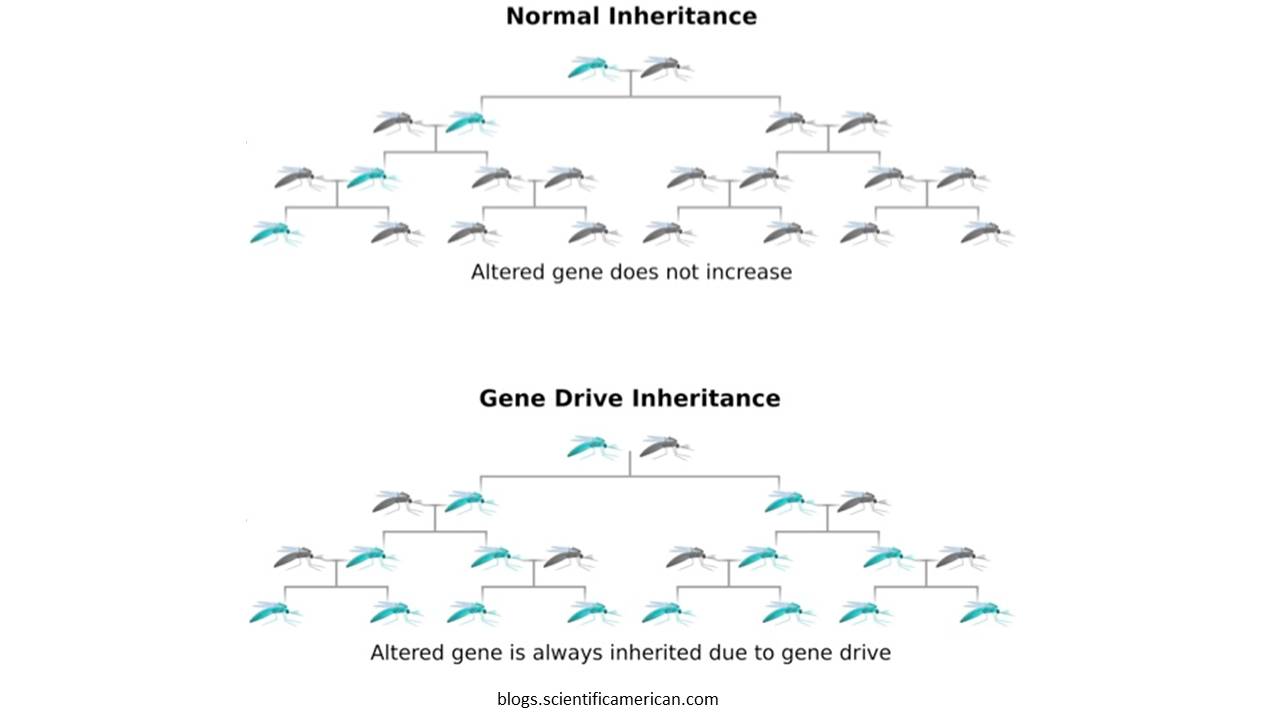A gene drive system enables a quick and wide spread of a genetic trait within a population of a particular organism. This effect on a trait is especially feasible in organisms with a short generation time. Gene drives are only effective in sexually reproducing organisms.
Gene drive systems have been known to occur in nature, but only recently have molecular biology advances made it possible to create such systems through biotechnology methods.
A ‘driving’ construct typically consists of two components: A gene or genes encoding an enzyme that recognizes a DNA sequence located in the homologous position of the chromosome where the construct is integrated, and a gene that encodes the trait of interest. While there are different ways to accomplish this goal, the CRISPR-Cas9 gene editing technique is currently the most widely used.

Application of a gene drive is possible in practices related to health, agriculture and ecology. An example is the application of a gene drive in insects aiming at preventing or even eradicating from certain areas vectors of serious diseases like Malaria, dengue and Lyme. Other possible applications are making resistant insects susceptible to natural toxins, or reducing the chances of survival of invasive or exotic species.
Applications of gene drives are currently only in the R&D phase. Recently described gene drives are applied in fruit flies and mosquitoes and are focused on inheritance and stability.
Some publications and links of interest:
- Requirements for Driving Antipathogen Effector Genes into Populations of Disease Vectors by Homing (Lub rau hli ntuj 2017)
- Synthetic gene drives in Australia: implications of emerging technologies, (Tej zaum 2017)
- Agricultural pest control with CRISPR based gene drive: time for public debate (Tej zaum 2017)
- http://www.pbs.org/wgbh/nova/next/evolution/gene-drive-resistance/
- First Gene drives in mammals (Lub ob hlis ntuj 2017)
- Gene drives thwarted by emergence of resistant organisms (Xwm, Lub ib hlis ntuj 2017)
- Modeling Gene Drives in Africa – Seasonal, Spatial and Epidemiological Considerations, (Lub ib hlis ntuj 2017)
- Reckless Driving: Gene Drives and the end of nature (2016)
- US National Academies report on gene drives, (2016)
- Public briefing on Wednesday, Lub rau hli ntuj 8 2016 ntawm 10:00 a.m. EDT for the release of Gene Drives on the Horizon: Advancing Science, Navigating Uncertainty, and Aligning Research with Public Values,
- News message Dutch GMO Office, 2016
- Xwm, 2016
- Nature Reviews, 2016
- http://harvardmagazine.com/2016/05/editing-an-end-to-malaria
- http://www.targetdna.com.br/genome-editing-and-gene-drive-potential-and-risks/http://www.targetdna.com.br/genome-editing-and-gene-drive-potential-and-risks/
- Concerning RNA-guided gene drives for the alteration of wild populations
- Seeing the upside in gene drives’ fatal flaw, 2016
The page “Gene-drives member area” offers further background information and a possibility for PRRI members to exchange information and comments.
Non PRRI members are welcome to send suggestions and comments to: [info-at-prri.net].
Ib pab neeg PRRI ntsib, ua los ntawm cov Dr. Hector Quemada of the Donald Danforth cog Science Center, yog xyuas thiab tawm tswv yim txog ntaub ntawv tshiab kom txhob muab kho dua no nplooj. Lwm cov neeg PRRI no loj hlob cus plaws caw mus nhriav lawv koom rau qhov kev pab ntawm: INFO @ prri.net.
